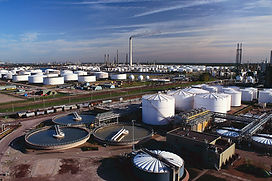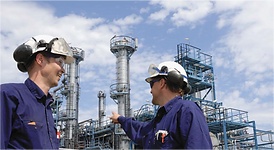
Özlem Academy Education Consultancy Inc.
CONTACT US FOR YOUR QUESTIONS
Address : Tatlısu Mah. Pakdil Sok. PERSPECTIVE Plaza No:5 Floor:1 Flat:3, Şerifali Cd., 34774 Umraniye/Istanbul
Tel Office: +90 (216) 594 55 25
Mobile-1: +90 (533) 380 83 72
Mobile-2: +90 (536) 746 97 34

Our services
We offer the highest quality Safety Report preparation service with our expert staff.
You can entrust us with your "Quantitative Risk Assessment" studies within the scope of the Seveso Directive!
What is the Seveso Directive?
The Seveso directive is a European Union regulation that aims to reduce possible risks during the use and storage of hazardous chemicals in businesses. This directive aims to manage the effects of accidents caused by hazardous materials in large-scale industrial plants.
Requirements and Application:
-
Businesses should make their own risk assessments based on the amount and characteristics of hazardous chemicals.
-
Businesses should identify hazard scenarios and develop contingency plans.
-
As a result of risk assessments, the security measures to be taken should be determined.
-
Businesses must publicly report their facilities within certain limits.
We offer the highest quality Safety Report preparation service with our expert staff.
You can entrust us with your "Quantitative Risk Assessment" studies within the scope of the Seveso Directive!
What is the Seveso Directive?
The Seveso directive is a European Union regulation that aims to reduce possible risks during the use and storage of hazardous chemicals in businesses. This directive aims to manage the effects of accidents caused by hazardous materials in large-scale industrial plants.
Requirements and Application:
-
Businesses should make their own risk assessments based on the amount and characteristics of hazardous chemicals.
-
Businesses should identify hazard scenarios and develop contingency plans.
-
As a result of risk assessments, the security measures to be taken should be determined.
-
Businesses must publicly report their facilities within certain limits.

We Prepare Your Safety Reports in the Best Way.
"Reducing Risks is Our Mission!"
Safety Report
Article 11 - (1) The operator of a high-level organization shall prepare or have prepared a security report taking into account the matters specified in the notification related to the security report, provided that it contains at least the information specified in Annex-2, and shall keep it in the organization. The security report is a document containing the introduction of the organization, the activities and processes carried out in the organization, and information related to the security management system implemented in the organization as specified in Annex-3.
1.Introduction of the Organization and Facilities 1.1. Introduction of the Organization 1.1.1. Historical development and origin of the organization. This information explains when and how the organization was established.
1.1.2. Details regarding whether the operator is part of a large company group. This explains the structure and relationships to which the business belongs.
1.1.3. Registration number of the organization in the Social Security Institution. This is necessary for verifying official records.
1.1.4. Determined based on the date of report preparation:
a) Number of male and female employees and number of shifts.
b) Titles, areas of activity, and number of employees of subcontractors.
1.1.5. Satellite image showing the boundaries of the area where the organization is located and its surroundings. This visualizes the physical location and environmental factors.
1.1.6. Summary information on the main activities and production in the organization. This defines the function and activities of the organization.
1.1.7. A copy of the declaration submitted to the Ministry of Environment and Urbanization's notification system under the "Organization Information" page. This verifies and documents official environmental notifications.
1.2. Site Plan of the Organization
1.2.1. Scale site plan of the entire organization. This shows the area and facilities of the organization in detail and marks facilities at risk of major accidents.
1.3. Introduction of the Organization's Surroundings
1.3.1. Information about neighboring businesses:
a) Titles and areas of activity of neighboring businesses.
b) Possible restrictions in intervention in emergencies.
1.3.2. Information about the environmental structure of the organization:
a) Hazards such as earthquakes, floods, landslides.
b) Other environmental hazards that could affect major industrial accidents.
1.3.3. Meteorological information: a) Lightning, storms, and other meteorological hazards.
1.3.4. Information on previous activities in the area and surroundings of the organization.
1.3.5. Information about other activities around the organization, such as pipelines, mining, transportation activities, and high-voltage power transmission lines.
1.4. Introduction of Facilities in the Organization:
1.4.1. General information about facilities in the organization:
-
The number and names of facilities are specified.
-
The number of employees and shift pattern (if any) is indicated.
-
The dates of commissioning and capacities of facilities are provided.
-
Information is given about the process relationship between facilities and planned shutdown periods.
-
1.4.2. Detailed information about the facility in the organization:
The names of the facilities specified in this section are written in bold, and the required information for each facility is provided.
1.4.3. Information on facility layout:
-
Places where storage activities are carried out and the name and quantity of stored materials are specified.
-
Places where process activities are carried out and what these activities are shown.
-
Locations of control rooms belonging to the facility are specified.
-
The type and locations of security systems used for monitoring facility entrances are provided.
-
Entrances to the facility via road, railway, port, and warehouse are explained.
1.4.4. Information on explosion and fire fighting measures:
Measures taken against fire/explosion situations that may arise from hazardous substances are explained.
1.4.5. Information on measures against spread in case of accidents:
Measures taken to restrict and prevent the spread of hazardous substances in the event of a major accident are explained.
1.4.6. Other information:
Information is provided about the process conditions where hazardous substances are processed, stored, transferred, and measures taken against these substances.
1.5. Hazardous Substances in the Organization:
Information is provided about hazardous substances present in the organization.
2.1.1.1 Organization Structure:
-
The organization chart of the organization is presented.
-
The unit responsible for process safety is indicated on the chart.
-
The titles, duties, and responsibilities of employees in this unit are explained.
-
In case of temporary absence of personnel in this unit, who will be assigned to their positions is specified.
-
The responsibilities of personnel responsible for preventing major industrial accidents at every level of the organization are specified.
-
Methods of informing all employees, including subcontractors or employees of temporary employment relationships, are explained.
2.1.1.2 Safety Culture of the Organization:
Information is provided about the safety culture where regular and continuous participation of all employees, including subcontractors, is ensured.
Methods used such as safety meetings, training, reward-penalty systems, and personal safety performance monitoring are explained.
2.1.1.3 Training of Assigned Personnel:
Minimum information is provided about the training received by personnel involved in preventing major industrial accidents.
Information is provided about the training topics, durations, and the institutions or individuals providing safety services.
2.1.1.4 Training Needs:
The unit responsible for planning and conducting employee training is specified.
Methods for determining training needs, training periods, and measurement and evaluation of employee performance are provided.
2.1.1.5 Monitoring of Safety Developments:
How major accidents and developments are monitored within the organization and in other organizations is explained.
Information is provided on the monitoring of legal regulations, national/international scientific methods, and technological developments.
2.1.1.6 Safety Information Exchange:
Information is provided about the information exchange system between emergency service units, relevant institutions, and the organization.
2.1.1.7 Subcontractor Management:
Regulations regarding the selection, management, coordination, and supervision of subcontractors are explained.
2.1.2 Identification and Evaluation of Major Accident Hazards:
2.1.2.1 Methodology:
The organization explains in detail the methods used to identify and assess major accident hazards.
2.1.2.2 Data Sources:
Information is provided about the sources of reliable reliability and probability data used to identify major accident hazards and assess the risks they pose.
2.1.3 Operation Control:
Necessary information for the following operating stages is provided for all facilities of the organization:
2.1.3.1 Commissioning of the Facility:
a. Commissioning Team: Selection criteria for individuals involved in the commissioning process of the facility are specified.
b. Control of Facility Installation: Methods used to verify the installation of the facility are explained in detail.
c. Control of Instrumentation System: Information is provided about the transmission of alarm and control signals and the control of cable connections.
d. Equipment Cleaning: Methods for cleaning pipeline installations and other equipment are explained.
e. Evaluation of Auxiliary Equipment: Methods for verifying the performance of auxiliary equipment such as pumps, fans are specified.
f. Calibration of Instruments: Information is provided on the calibration of instruments and the methods for controlling alarm limit values.
g. Commissioning Activities: Activities carried out to make the facility operational and verify the installation are explained.
h. Rectification of Defects: Methods for rectifying defects identified during checks and updating relevant documents are specified.
2.1.3.2 Operation of Facilities and Processes:
a) Control and Alarm Systems: Information is provided about the control and alarm systems used in storage and process activities.
b) Maintenance Policy and Implementation: Information is provided on how preventive and corrective maintenance is planned and implemented.
c) Work Instructions and Permit Systems: Information is provided about instructions prepared to prevent major industrial accidents and permit systems.
ç) Periodic Inspection of Process Equipment: Information is provided on the periodic inspection and corrective actions of equipment such as pressure vessels, tanks, pipelines.
2.1.3.3 Decommissioning of Process Equipment:
Information is provided on planning, selection of responsible and assigned personnel, and determination of safety measures for decommissioned process equipment.
2.1.4 Change Management:
Methods for identifying critical changes are explained.
Information is provided about the content and management of critical changes such as organizational, personnel, process, equipment changes.
The process of identifying and preventing hazards due to changes, recording changes, and updating documents, and informing employees due to changes are explained.
2.1.5 Planning for Emergency Situations:
Information is provided about the internal emergency plan prepared by the operator, criteria determined, emergency organization, training activities, and drills.
2.1.6 Monitoring Performance:
Information is provided about setting goals for the safety management system, monitoring compliance, reporting adverse conditions, and managing major accidents.
2.1.7 Inspection and Review:
The internal audit process conducted at intervals of less than two years is explained, including the selection of auditors, their authority and responsibilities, audit methods, reporting results, and informing top management.
Please review the Article and Blog section in order to have a detailed idea about our process safety and GYS audit studies.

Employer's Obligation to Take Action
Regulation on Preventing Major Industrial Accidents and Reducing Their Effects
Article 6:
General Obligation of the Operator
The operator is obliged to take all necessary measures to prevent major accidents and, in cases where it cannot be prevented, to limit their effects in a way that causes the least damage to the environment and people.









